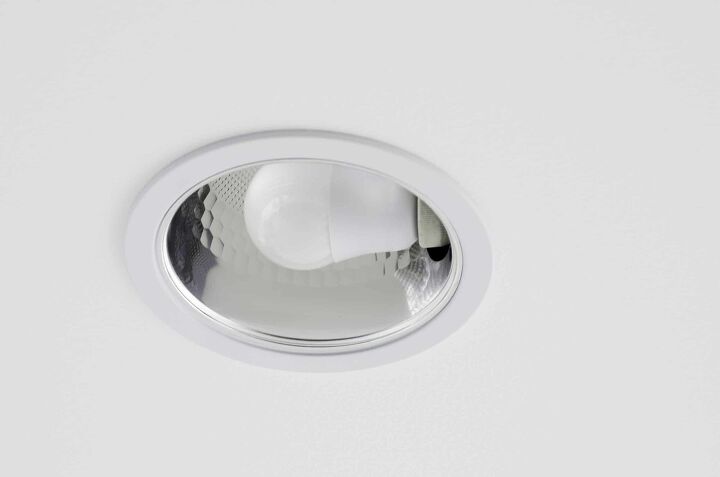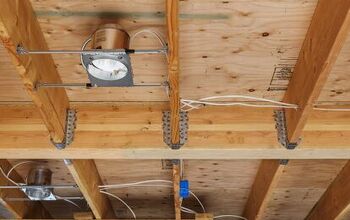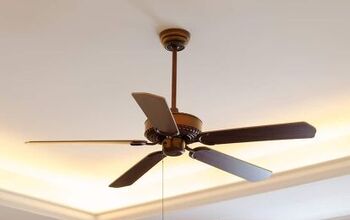How To Tell If Recessed Lighting Is IC Rated

Recessed light fixtures are often a significant part of interior design. Home inspectors and electricians recommend that all recessed light fixtures carry an IC or IC-AT rating. Without paying someone to come to look at your lights, how do you tell if recessed lighting is IC rated?
Turn off the power to your recessed lighting fixture and remove the trim ring and bulb. Inspect the inside of the lighting fixture and look for a manufacturer’s label. Read the label and look for “IC” or “IC-AT” near the model number to indicate that it is IC rated.
There are several reasons to make this check for IC-rated light fixtures.
- Economy
- Efficiency
- Safety
Making sure your recessed fixtures have the IC rating is vital to protect your budget, your family, and your home,
Do You Need to Hire an Electrician?
Get free, zero-commitment quotes from pro contractors near you.

What is an IC Rated Lighting Fixture?
IC Rated simply stands for “insulation contact” rated. If a recessed lighting fixture, or downlight, has been given an ‘IC’ rating, this means that the product has been deemed suitable to be covered with building insulation. In other words, the fixture can come into contact with insulation, which is not the case with most recessed lights.
This means that lights that are labeled non-IC rated cannot come into contact with insulation. Your home most likely (and it should) has insulation in the roof, which is in place to improve energy efficiency, regulate temperature, and reduce your heating/cooling expenses. Though, the drawback to insulation is that it can be flammable and installing electrical appliances or lighting near insulation can present a fire hazard.
Ceiling downlights, especially those with halogen bulbs, can reach incredibly high temperatures to produce light. In fact, halogens can reach temperatures higher than 570 degrees Fahrenheit, or 300 degrees Celsius. This obviously creates a very dangerous situation when placed near ceiling insulation and why IC rated lighting fixtures are so beneficial.
What is the Significance of the IC and IC-AT Ratings?
Older fixtures that don’t carry and IC or IC-AT rating have several disadvantages. The old style of a recessed fixture with no rating was unsafe if insulation came into contact with the fixture. Installers were warned in the instructions not to allow insulation to cover these fixtures.
These old fixtures had holes in the housing and depended on air circulation through the housing to keep the light fixture cool. Anything blocking this air movement risked overheating the light fixture.
These fixtures also acted as mini-chimneys. The cooling action sucked the air from the interior into the attic, making them extremely inefficient. During winter, the warm flowing into the attic could create ice damming and condensation problems in the attic
The IC Rating – Insulation Contact
Later models of recessed fixtures carry the IC rating. These fixtures are acceptable for installation where they are covered or buried by insulation. The IC rating is a significant improvement in the economy and safety.
Most of these fixtures also have a thermal switch. If the recessed fixture gets too hot, the thermal switch turns the light off. When the fixture cools, the light comes back on. However, some IC-rated recessed fixtures still leak inside air into the attic.
IC-AT – The Best Choice
The latest innovation in recessed lighting fixtures is those with the IC-AT rating. The AT addition indicates that the fixture is airtight. In addition to the IC-AT rating, many of these IC-AT labeled fixtures carry an additional ASTM E283 label.
The fixtures with the ASTM E283 label have been laboratory tested for air leakage. Installing an ASTM E283 labeled fixture is the best way to ensure that your home is as airtight as possible.
Verifying If Your Fixtures Are IC-Rated
Most newer homes have recessed fixtures that are rated IC or IC-AT. Even if your home is relatively new, it is a good idea to check the rating on your light fixtures. Homebuilders have saved a few dollars by installing non-rated fixtures.
Step 1 – Be Safe and Turn off the Power to the Light Fixture
Never attempt to work on a light fixture or any other part of your home electrical system while energized. Messing around with live electricity is an invitation to injury or worse. Locate the breaker that serves the circuit and flip it to the off position.
The easiest way to make sure that you have flipped the right breaker is to turn on the lights and then turn off the breaker. If the lights go out, it is a good sign you have the right breaker. With the breaker off, you can safely work with the recessed light fixture.
For more information about your homes electrical system and maintenance, check out this article.
Step 2 – Remove the Trim and the Bulb
Different styles of recessed light fixtures have different methods of attaching the trim rings. The most common methods of attaching trim rings are:
- One type is friction tabs, which grip the housing of the fixture. These usually slip off easily.
- Another style uses small springs that hold the trim ring in place. These may require you to unlatch the spring from the trim ring. Unlatching the springs is usually easier done if you can remove the bulb first.
- The third type of trim attachment is the twist lock. This type of attachment has lugs on the trim ring that engage slots on the housing. When the lugs are engaged, and the ring turned, the lugs pull the trim ring uptight.
With the trim ring and bulb removed from the fixture, you are ready to look for the rating on your recessed light fixture.
Step 3 – The Tell-Tale Clues
You may be able to figure out if your recessed fixture is IC rated simply by the design. If you can see any holes opening directly into space above, your fixture is probably not IC-rated. There are a few IC-rated recessed fixtures that are not air-tight.
To be entirely sure if your recessed fixtures carry an IC-rating, you must find the manufacturers label.
Step 4 – Look for the Label
Inside the recessed fixture, you should be able to locate the manufacturer’s label. This label will give you a lot of information about the fixture. Look for the letters “IC” or “IC-AT” located near or part of the fixtures model number. If the labels have these letters, your recessed fixture rates for that type of use and installation.
Other Options – Making your Non-IC Rated Fixtures Safer
There are other options beyond replacing your recessed lighting fixtures. Of course, replacing your non-IC rated fixtures with new IC-AT rated fixtures is always the best option. If you chose to go another route, there are some methods you can employ
Install a Fixture Box in the Attic
You can buy or build a box that will fit over your recessed light fixture in the attic and keep the insulation from contacting the fixture. Most of the available boxes are built from a polycarbonate sheet material that has a foil facing.
You can buy this material and construct your boxes if you so choose. The easiest method is to cut the polycarbonate material to size and use adhesive-backed foil tape to put the pieces together.
To install the box, move the insulation away from the light fixture. The box must sit tightly on the ceiling surface below. Seal the box to the ceiling surface with adhesive-backed aluminum tape. When the box is secure, move the insulation back around and over the box
Insulation Caps – Put a Hat on your Light Fixture
You can also purchase insulation caps. These fixture caps are made from mineral wool and have excellent insulation value are fire retardant. Like the box, these insulation caps fit over the recessed fixture and hold the surrounding insulation safely away.
Installation of these caps is much like installing a box. The caps don’t seal to the ceiling surface around the light fixture allowing minimal air circulation through the light fixture.
The Downside to Fixture Boxes and Caps
Both caps and boxes restrict airflow through the light fixture. On non-IC rated fixtures, the lack of airflow can cause overheating. Lack of airflow can be a safety issue in some cases. At best, overheating will shorten the life of the bulbs in the fixture. At worst, it can be a fire hazard.
If you have questions about your attic insulation, this article may give you the answers you need.
Do You Need to Hire an Electrician?
Get free, zero-commitment quotes from pro contractors near you.

Making Your Home Safer & More Efficient With IC Rated Fixtures
Whether you aim for energy efficiency or a safer environment, inspecting your recessed lighting fixtures is a good idea. Determining if your fixtures are IC rated or not is relatively quick and easy. We hope that these simple steps and the basic information help you achieve your goals in your home.
Related Questions
Are all recessed lighting fixtures IC rated?
Not all recessed lights are IC rated, which makes determining whether or not a fixture is IC rated very important. One tell-tale distinction is if the can has slits or holes in it, the fixture is not IC rated. Try to locate an Underwriters Laboratory sticker on the light, with the letters “IC” to indicate that the fixture is IC rated.
Do downlights need to be fire rated?
For you, your family, and your home’s protection, it is highly advised that all the downlights you install are fire rated. These lights help to slow the spread of fire in a home and give occupants more time to escape safely.
More Related Articles

We are a team of passionate homeowners, home improvement pros, and DIY enthusiasts who enjoy sharing home improvement, housekeeping, decorating, and more with other homeowners! Whether you're looking for a step-by-step guide on fixing an appliance or the cost of installing a fence, we've here to help.
More by Upgraded Home Team



























